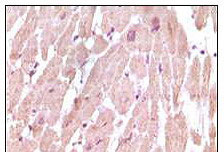cTnI Antibody
Purified Mouse Monoclonal Antibody
- SPECIFICATION
- CITATIONS: 2
- PROTOCOLS
- BACKGROUND

Application
| WB, IHC, E |
|---|---|
| Primary Accession | P19429 |
| Reactivity | Human |
| Host | Mouse |
| Clonality | Monoclonal |
| Clone Names | 3A10A12; 5C3A7 |
| Isotype | IgG1 |
| Calculated MW | 24008 Da |
| Description | cTnI has an apparent molecular weight of 22.5 kDa. cTnI is a candidate marker with acceptable sensitivity and specificity for AMI and other cardiac diseases. Troponin, a molecule that binds to the thin filament (actin) of striated muscle fibers, acts with intracellular calcium to control the interaction of the thin filament with the thick filament (myosin), thus regulating muscle contraction. Troponin I prevents muscle contraction in the absence of calcium, which has two skeletal muscle isoforms with considerable amino acid sequence homology. cTnI contains an additional N-terminal sequence and is highly specific for myocardium. |
| Immunogen | Purified recombinant fragment of cTnI expressed in E. Coli. |
| Formulation | Ascitic fluid containing 0.03% sodium azide. |
| Gene ID | 7137 |
|---|---|
| Other Names | Troponin I, cardiac muscle, Cardiac troponin I, TNNI3, TNNC1 |
| Dilution | WB~~1/500 - 1/2000 IHC~~1/200 - 1/1000 E~~N/A |
| Storage | Maintain refrigerated at 2-8°C for up to 6 months. For long term storage store at -20°C in small aliquots to prevent freeze-thaw cycles. |
| Precautions | cTnI Antibody is for research use only and not for use in diagnostic or therapeutic procedures. |
| Name | TNNI3 |
|---|---|
| Synonyms | TNNC1 |
| Function | Troponin I is the inhibitory subunit of troponin, the thin filament regulatory complex which confers calcium-sensitivity to striated muscle actomyosin ATPase activity. |

Provided below are standard protocols that you may find useful for product applications.
References
1. Cummins B and Cummins P, J Mol Cell Cardiol, 1987, 19(10):999-1010. 2. Cummins B, Auckland ML, and Cummins P, Am Heart J, 1987, 113(6):1333-44. 3. Darnell J, Lodish H, and Baltimore D, Molecular Cell Biology, New York, NY: Scientific American Books, 1986, 827-8. 4. Larue C, Defacque-Lacquemant H, Calzolari C, et al, Mol Immunol, 1992, 29(2):271-8. 5. Adams JE III, Bodor GS, Davila-Roman VG, et al, Circulation, 1993, 88(1):101-6.
If you have used an Abcepta product and would like to share how it has performed, please click on the "Submit Review" button and provide the requested information. Our staff will examine and post your review and contact you if needed.
If you have any additional inquiries please email technical services at tech@abcepta.com.














 Foundational characteristics of cancer include proliferation, angiogenesis, migration, evasion of apoptosis, and cellular immortality. Find key markers for these cellular processes and antibodies to detect them.
Foundational characteristics of cancer include proliferation, angiogenesis, migration, evasion of apoptosis, and cellular immortality. Find key markers for these cellular processes and antibodies to detect them. The SUMOplot™ Analysis Program predicts and scores sumoylation sites in your protein. SUMOylation is a post-translational modification involved in various cellular processes, such as nuclear-cytosolic transport, transcriptional regulation, apoptosis, protein stability, response to stress, and progression through the cell cycle.
The SUMOplot™ Analysis Program predicts and scores sumoylation sites in your protein. SUMOylation is a post-translational modification involved in various cellular processes, such as nuclear-cytosolic transport, transcriptional regulation, apoptosis, protein stability, response to stress, and progression through the cell cycle. The Autophagy Receptor Motif Plotter predicts and scores autophagy receptor binding sites in your protein. Identifying proteins connected to this pathway is critical to understanding the role of autophagy in physiological as well as pathological processes such as development, differentiation, neurodegenerative diseases, stress, infection, and cancer.
The Autophagy Receptor Motif Plotter predicts and scores autophagy receptor binding sites in your protein. Identifying proteins connected to this pathway is critical to understanding the role of autophagy in physiological as well as pathological processes such as development, differentiation, neurodegenerative diseases, stress, infection, and cancer.


